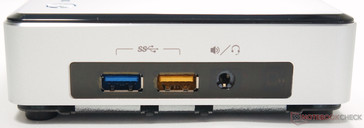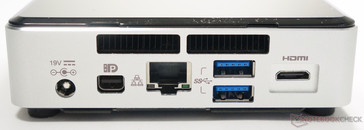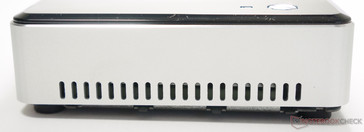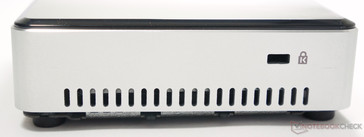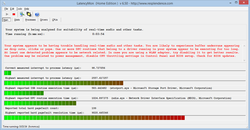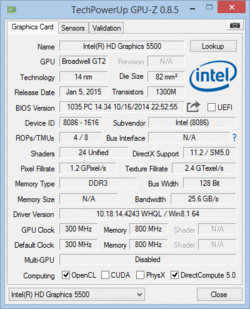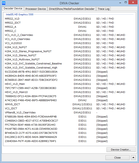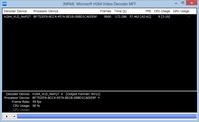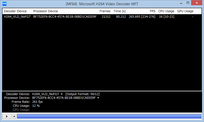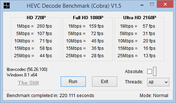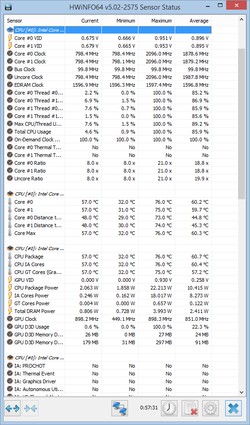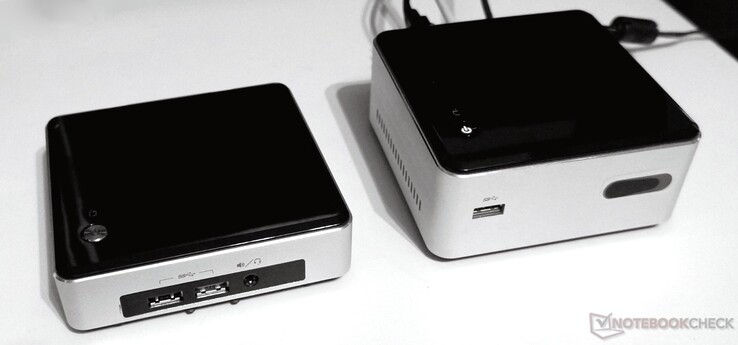Intel NUC5i3RYK Mini PC (Broadwell Core i3-5010U) Review
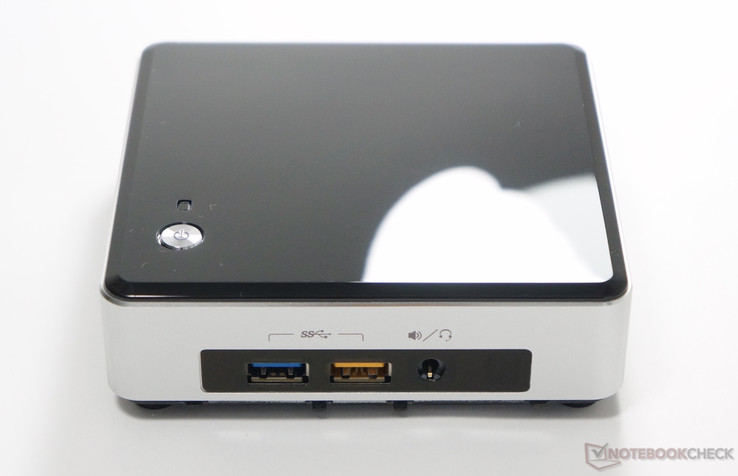
For the original German review, see here.
The NUC (next unit of computing) lineup from Intel offers barebones with up-to-date laptop technology in a slim casing. This mini-PC is presently available in two differently sized casings, one with a 2.5-inch drive bay and one only with an M.2 SSD slot. Following our review of the Core i5 Broadwell NUC5i5RYH, we looked at the Core i3 model in a slimmer casing with the M.2 slot. Intel recommends the NUC kit for home entertainment, gaming and productivity. The following report will reveal whether that proves true.
Case & Connectivity
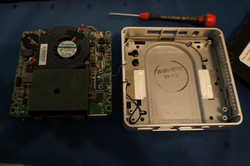
In contrast to the previously tested NUC5i5RYH, our review sample features a much slimmer casing. However, it does not have a bay for a 2.5-inch hard drive (which would be the NUC5iRYH model) but an M.2 slot for SSDs instead. It is also considerably lighter with less than half-a-kilogram (463 vs. 690 grams). The casing's design is similar, and the build also makes a high-quality impression. The glossy finished lid remains to be the weak point being very susceptible to scratches, dust and fingerprints.
Only four screws in the stoppers have to be released to access the M.2 slot and memory bar. Additional screws secure the motherboard to the casing. The whole unit can be removed after releasing the screws (caution: the Wi-Fi and Bluetooth antennas are connected to the casing). The small fan, heat sink and BIOS battery are in the rear.
The NUC kit is shipped without memory or SSD, but a VESA holder for the wall, for mounting a monitor, is in the box.
Performance
Our review sample sports an Intel Core i3-5010U Broadwell CPU, integrated Intel HD Graphics 5500, 8 GB of DDR3-1600 (PD3-12800), and an Intel 530 M.2 SSD with a capacity of 360 GB.
When the DPC latencies were idle without major spikes on the desktop they were also suitable for real-time audio usage (according to LatencyMon). However, some prolonged spikes appeared while browsing, which might get annoying during real-time applications.
Processor
The Core i3-5010U is situated in the entry-level sector of the Broadwell Core processors. It has two cores that clock at a maximum of 2.1 GHz. Like all Core i3 processors, the 5010U does not feature Turbo and can reach at most 2.1 GHz regardless of the load. The i3-5010U does not support vPro, TSX-NI or SIPP, either. However, it is Hyper-Threading capable and can thus process 4 threads simultaneously.
Our Cinebench R15 tests depict the performance that can be expected from the little Broadwell processor. The NUC achieves the same performance as the i3-5010U in Asus' F555LJ-XX110H (Test). A clear disadvantage of 16% to 20% is evident when compared to the Core i5-5250U version. The Celeron NUC based on the Bay Trail SoC is considerably slower, and that is - unlike the i3 to i5 difference - also noticed (e.g. in Internet browsing).
| Cinebench R15 | |
| CPU Single 64Bit (sort by value) | |
| Intel NUC5i3RYK | |
| Intel NUC5i5RYH | |
| Intel NUC Kit DN2820FYKH | |
| Intel NUC Kit DN2820FYKH | |
| CPU Multi 64Bit (sort by value) | |
| Intel NUC5i3RYK | |
| Intel NUC5i3RYK | |
| Intel NUC5i5RYH | |
| Intel NUC Kit DN2820FYKH | |
System Performance
Thanks to the swift SSD, the i3 NUC positions itself in the midfield of all tested systems in the PCMark 8 Home test. HP's Spectre 13 with a Core i5-5500U and SSD or also Lenovo's ThinkPad S5 Yoga 15 with a 5500U, GeForce 840M, and Samsung PM851 SSD, for example, are on precisely the same level. The NUC5i5RYK based on a Core i5-5250U and HD 6000 (same height as well as memory and SSD configuration) has an edge of 9%. The NUC5i5RYH (with 2.5-inch vector 150 SSD) is 6% faster. The cheap DN2820FYKH with a Celeron N2820 is clearly outperformed. It only achieves 40% of the Core i3's performance. Although Asus' F555LJ configured with the same CPU can only offer a slower hard drive, it features a GeForce 920M, and plays in the same league with a 2% lead. The fastest system is Eurocom's P5 Pro Extreme Workstation based on a desktop Core i7-4790K, GTX 980M, and SSD RAID. It can almost double the score with an advantage of 90%.
| PCMark 8 Home Score Accelerated v2 | 2901 points | |
| PCMark 8 Work Score Accelerated v2 | 3732 points | |
| PCMark 10 Score | 2391 points | |
Help | ||
| PCMark 8 - Home Score Accelerated v2 (sort by value) | |
| Intel NUC5i3RYK | |
| Intel NUC5i5RYH | |
| Core i5-5250U (Intel NUC) | |
| Intel NUC Kit DN2820FYKH | |
Storage Device
Intel's SSD 530 installed in our review sample utilizes the M.2 port and likely operates via SATA protocol. The maximum sequential read speed of 452 MB/s in the AS SSD benchmark demonstrates that. The SSD exhibits minor weaknesses in write, and thus the total score remains slightly behind top SSDs. The SSD nevertheless helps the NUC to a high responsiveness. Applications and games load fast, copying and unpacking ZIP files usually do not involve long waiting times.
Graphics Card
The NUC5i3RYK relies on the integrated Intel HD Graphics 5500 as its graphics card. It is the GT2 expansion stage of the Broadwell generation and offers either 23 or 24 EUs in the Core i3 models. According to GPU-z and LuxMark, it has 24 EUs in the i3-5010U and clocks at 300 MHz without load and 900 MHz under load. The 5500 in the i3-5010U fares very well compared with other HD 5500s in the synthetic benchmarks. It achieves 2nd place behind Schenker's S405 with a Core i7-5500U in the 3DMark 11 graphics score. It is still enough for the midfield in the Cloud Gate GPU score but is also on par with a Core i5.
| 3DMark 06 Standard Score | 7468 points | |
| 3DMark Vantage P Result | 4913 points | |
| 3DMark 11 Performance | 1298 points | |
| 3DMark Cloud Gate Standard Score | 4830 points | |
| 3DMark Fire Strike Score | 720 points | |
| 3DMark Time Spy Score | 289 points | |
Help | ||
| 3DMark - 1280x720 Cloud Gate Standard Graphics (sort by value) | |
| Intel NUC5i3RYK | |
| Intel NUC5i5RYH | |
| Intel NUC Kit DN2820FYKH | |
| 3DMark 11 - 1280x720 Performance GPU (sort by value) | |
| Intel NUC5i3RYK | |
| Intel NUC5i5RYH | |
| Intel NUC Kit DN2820FYKH | |
Gaming Performance
It was clear that the small Core i3 NUC would not prove to be the best gaming machine from the outset. Sophisticated games, such as Metro: Last Light were not playable with the integrated HD Graphics 5500. Only a few up-to-date games like CoD: AW or Civilization Beyond Earth could be rendered smoothly using the lowest settings. Although the frame rate stably remained over 30 fps in FIFA 15, the game was sometimes jerky. A look at the frame rates then revealed that the Core i3 periodically ran the processor cores at 1.4 GHz only. Apparently the TDP of 15 watts for the GPU and CPU limits the performance here since the temperatures clearly remained below the maximum of 105 °C.
More gaming benchmarks based on Intel's HD Graphics 5500 graphics card can be found here.
| low | med. | high | ultra | |
|---|---|---|---|---|
| Metro: Last Light (2013) | 20.4 | 16.3 | 11.6 | 5.7 |
| Fifa 15 (2014) | 36.3 | 28.8 | 17.6 | |
| Civilization: Beyond Earth (2014) | 38.3 | 18.1 | ||
| Call of Duty: Advanced Warfare (2014) | 33.2 | 16.9 | ||
| Dota 2 Reborn (2015) | 74 | 37.6 | 15.7 | 13.4 |
| World of Warships (2015) | 49.6 | 35.6 | 13.2 | |
| Rainbow Six Siege (2015) | 27 | 16.9 | 9.9 | 7.8 |
| Just Cause 3 (2015) | 16.3 | 14.4 | ||
| Doom (2016) | 0 game wont start | |||
| Overwatch (2016) | 31.6 | |||
| Mirror's Edge Catalyst (2016) | 21.5 | 12.6 | ||
| Farming Simulator 17 (2016) | 60.7 | |||
| Rocket League (2017) | 63.7 | |||
| Dirt 4 (2017) | 34.2 | |||
| Team Fortress 2 (2017) | 68 | 63 | 36 () | 14 () |
| X-Plane 11.11 (2018) | 17.1 | 11.8 | 10.5 | |
| Total War: Three Kingdoms (2019) | 18.3 | |||
| F1 2019 (2019) | 21.4 | |||
| Hearthstone (2020) | 29.3 |
Video Playback
The casing's small dimensions make the little NUC very suitable as a multimedia PC. The fan noise of the small desktop (more about that later) might be a problem for enthusiasts, but the hardware's capabilities advocate this field of use. The little i3 Broadwell coped with all 1080p content easily in our test. It depends on the bit rate and codec in 4K. H.264 was no problem thanks to, for example, hardware acceleration even at 100 MBit. WebM in YouTube, however, was an issue because 2.1 GHz simply overburdens both Broadwell cores. H.265 is "hybrid" supported, i.e. a mixture of CPU and GPU, since the last drivers released for it. The i3's performance is not sufficient in higher bit rates and 4K content.
Emissions & Energy Management
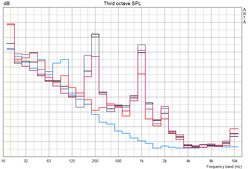
System Noise
The fan integrated in the small NUC is always audible and present even without load. The measured 34.9 dB is in no way loud, but a noiseless operation (like Apple, for example, manages in its laptops) would be desirable. The noise increases by a bit over 1 dB to 36 dB under load. The difference is barely audible and only sets in when the graphics card is loaded. The noise is not unpleasant subjectively, although it is not only a fan noise (see frequency chart). Compared with the Core i5 NUC (5i5RYH in a big casing) that we tested, the idle noise level was audibly higher and comparable under load or even lower. We did not discover the mentioned electronic chirping noise during graphics load.
Noise level
| Idle |
| 34.9 / 34.9 / 34.9 dB(A) |
| Load |
| 35 / 36 dB(A) |
 | ||
30 dB silent 40 dB(A) audible 50 dB(A) loud |
||
min: | ||
Temperature
The surface temperatures of the NUC based on i3 Broadwell were always uncritical in the test. The small cube mostly remained cool, and the hot spot of 47 °C on the upper side during maximum load was also no problem.
The internal temperatures recorded with HWInfo 64 are not disconcerting, either. The SoC's maximum of 73 °C is no issue since Intel specifies it with 105 °C.
We checked the temperatures and permanent performance in the stress test. The CPU's temperatures only climbed to 55 °C (Aida64) and 62 °C (Prime95) when solely the processor was loaded. The core clock remained stable at 2.1 GHz, and the fan only sped up marginally to 3330 rpm. Cinebench 15 ran in a loop also confirmed this impression. The results of the multi-core tests remained stable, and the NUC even managed its best rates toward the end (45 minutes runtime).
Throttling as seen in FIFA15 set in when the graphics card was added. The CPU's clock dropped permanently to 1.4 GHz when running Furmark and Prime95. The GPU also throttled from its initial 900 MHz to 700 MHz. However, the temperatures always remained uncritical at 71 - 73 °C (CPU and GPU cores).
(-) The maximum temperature on the upper side is 47 °C / 117 F, compared to the average of 33.9 °C / 93 F, ranging from 25 to 47 °C for the class Desktop.
(+) The bottom heats up to a maximum of 34 °C / 93 F, compared to the average of 33.6 °C / 92 F
(+) In idle usage, the average temperature for the upper side is 29.1 °C / 84 F, compared to the device average of 29.5 °C / 85 F.
Power Consumption
The power consumption of 6.4 to 36 watts is very moderate for a desktop system and can clearly undercut the Core i5 NUC in the bigger casing (and with a more power guzzling 2.5-inch SSD) (for comparison: 7.6 to 42.4 watts).
The i3 NUC reached its maximum power consumption of 36 watts within the first seconds of full load via Prime and Furmark. However, it quickly dropped to a moderate 26 watts because the i3 started to throttle. The same phenomenon became obvious in Furmark (from 33 to 36.5 watts), so it is not just processor throttling. That is unlikely due to the temperatures seeing that the internal sensors only recorded a maximum of 73 °C in HWInfo 64.
| Off / Standby | |
| Idle | |
| Load |
|
Key:
min: | |
Pros
Cons
Verdict
Like in the previous test of the Core i5 NUC, we can draw a positive conclusion for the Core i3 version in the smaller casing (RYK). The little dwarf scores with its compact casing, appealing design, and good build. The components are easy to access and to maintain. The small desktop is very suitable for office and video (mainly 1080p). The performance of the installed components is, as expected, good. Stutters might turn up only in games because the CPU cores throttle. A somewhat quieter fan would also be pleasing when used in the living room, even if the one installed is not noticed adversely.
Intel can fulfill the promise of "good" performance in the home entertainment and productivity fields. However, unfortunately, some compromises have to be made in gaming since not only the theoretical performance of the Core i3 is limited, but also because the processor cores are clocked down during graphics load.
Linux on the i3 NUC
According to Andrey of our Russian notebookcheck-ru.com, the Core i3 model runs Linux with an up-to-date Kernel (3.13 and newer) without issues (he tested e.g. Ubuntu 12.03).


